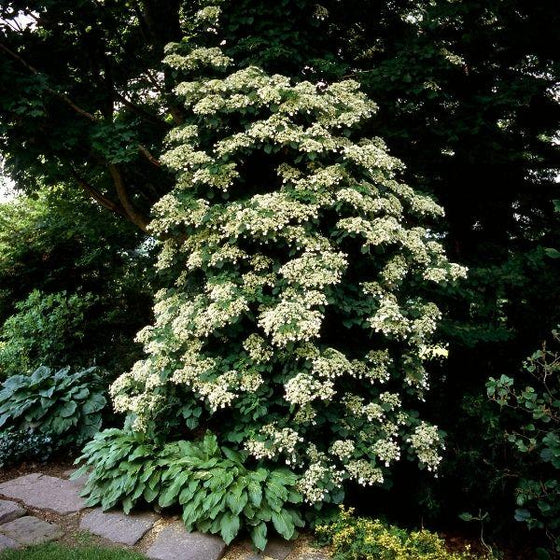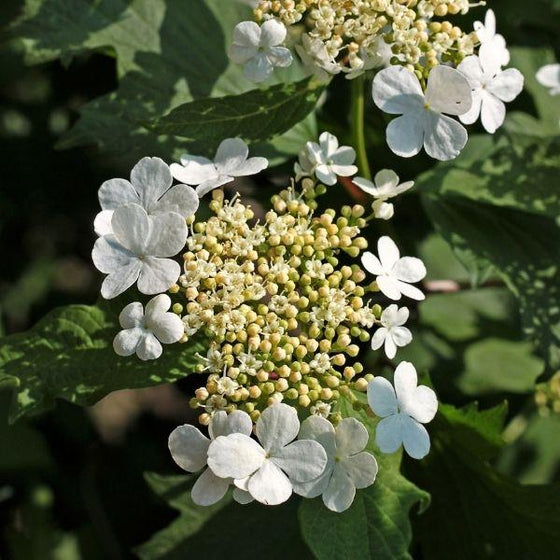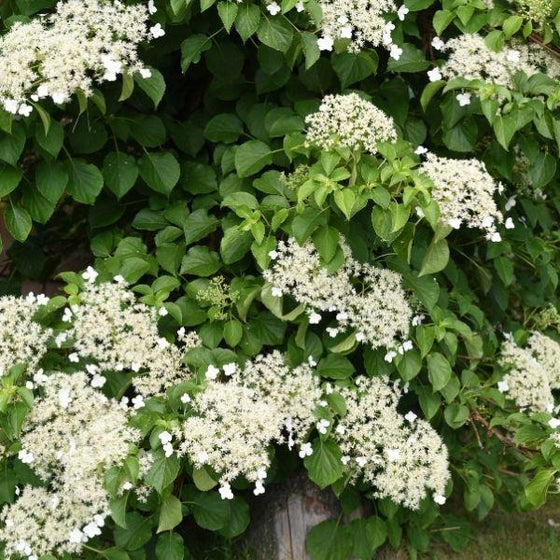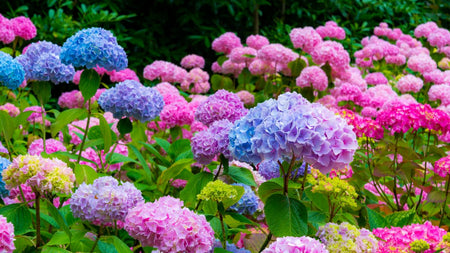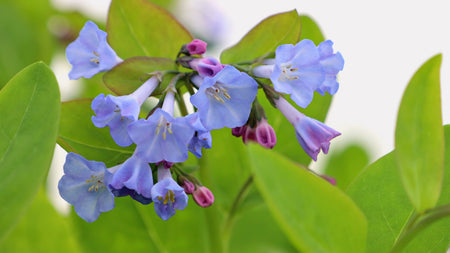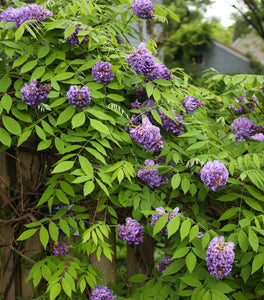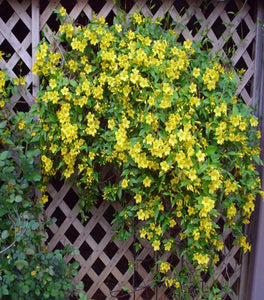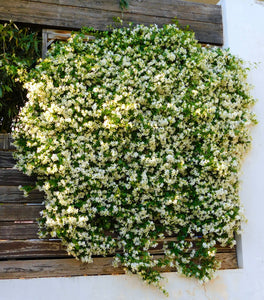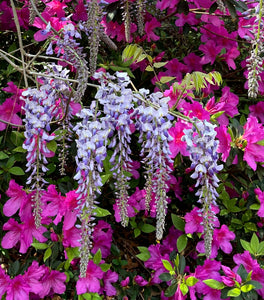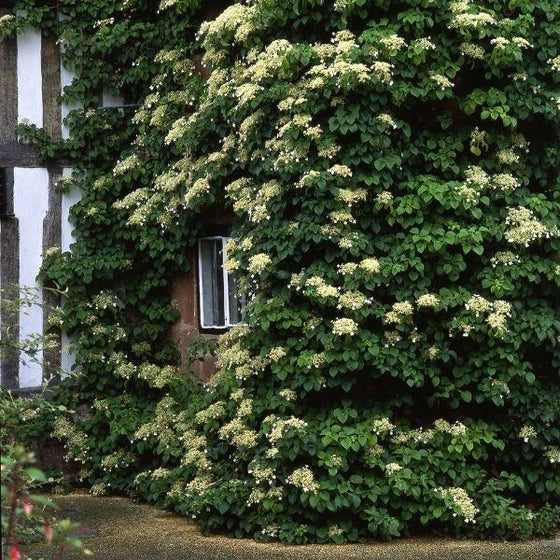
Images Depict Mature Plants
Climbing Hydrangea – Shade-Loving Flowering Vine for Walls, Fences, and Arbors
A graceful climber that transforms any space.
The Climbing Hydrangea (Hydrangea anomala subsp. petiolaris) is one of the most enchanting vines for shaded gardens. Known for its large clusters of creamy white blooms and luxurious green foliage, this hardy perennial brings life and texture to walls, fences, pergolas, and arbors. Its self-clinging aerial roots make it easy to grow on almost any surface — no support wires required.
Shade-loving and incredibly adaptable.
Unlike many flowering vines, Climbing Hydrangea thrives in partial to full shade, making it an excellent solution for north-facing walls or woodland gardens. Once established, it grows 10–30 feet tall and forms a dense, lush covering of heart-shaped leaves that provide four-season interest — from spring blooms to cinnamon-brown bark in winter.
Low-maintenance beauty year after year.
This vine is cold-hardy, deer-resistant, and long-lived, requiring little more than occasional pruning to control its spread. In early summer, it bursts into bloom with flat-topped clusters of fragrant white flowers, attracting pollinators and adding light to even the darkest garden corners. Its elegant growth and easy care make it a favorite among both landscapers and home gardeners.
A natural fit for timeless landscapes.
Whether you’re softening a stone wall, creating a living fence, or dressing up a shaded patio, the Climbing Hydrangea is a versatile, resilient choice. Few plants combine fragrance, adaptability, and classic beauty with such effortless grace. Plant it once, and enjoy decades of cascading blooms and lush greenery.
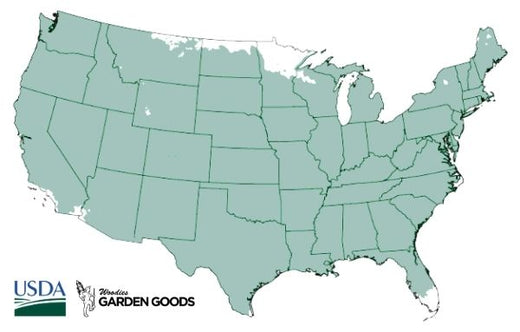
| Hardiness Zone: | 4-9 |
|---|---|
| Mature Width: | 30 to 40 Feet (If left to grow) |
| Mature Height: | 6 to 10 Feet |
| Classification: | Vine style hydrangea |
| Sunlight: | Full sun to part shade |
| Habit: | Climbing; vine-like |
| Flower Color: | Pure white blooms early summer to early fall |
| Foliage: | Dark green |
| Pruning Season: | Late winter to early spring, promotes increased branching and more flowers. Flowers on new growth |
| Soil Condition: | Any well drained soil |
| Water Require: | Water well until established |
| Uses: | Extremely attractive when used as a privacy shrub when paired with a trellis |
How to Care for Climbing Hydrangea
Be sure to read our planting instructions to ensure a healthy and happy Climbing Hydrangea for years to come!
How do I plant a Climbing Hydrangea?
Choose a spot with partial to full shade and moist, well-drained soil. Dig a hole twice as wide as the root ball and the same depth. Loosen the soil at the bottom and mix in compost to improve drainage. Place the plant so the top of the root ball is level with the soil surface, backfill, and water thoroughly. Provide a wall, fence, or trellis for the vine to climb. Climbing Hydrangea attaches itself with aerial rootlets, so it doesn’t need wire supports, but it may take a year or two to fully establish before vigorous growth begins.
How often should I water Climbing Hydrangea?
Water your Climbing Hydrangea deeply once or twice a week, especially during hot or dry spells. Keep the soil consistently moist but not soggy — the plant thrives best in rich, well-hydrated conditions. Mulching around the base with organic material helps retain moisture and regulate soil temperature. Once mature, Climbing Hydrangea is somewhat drought-tolerant, though consistent watering promotes fuller flowering and lush foliage.
When should I fertilize my Climbing Hydrangea?
Feed in early spring with a balanced, slow-release fertilizer formulated for flowering shrubs. Apply evenly around the root zone, keeping it a few inches away from the stem. Fertilizing once a year is typically sufficient. Over-fertilizing can result in lush foliage with fewer flowers, so aim for moderate feeding paired with good soil health.

How do I prune a Climbing Hydrangea?
Prune in late winter or early spring before new growth appears. Remove dead, weak, or crossing branches to maintain shape and encourage airflow. If needed, lightly trim after flowering to control size. Avoid heavy pruning into old wood, as flowers develop on older stems. With gentle annual maintenance, Climbing Hydrangea will stay healthy and vigorous for decades.

